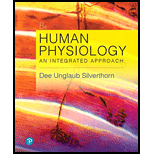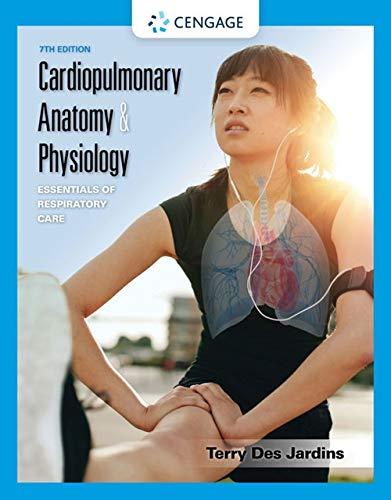
EBK HUMAN PHYSIOLOGY
8th Edition
ISBN: 9780134704227
Author: Silverthorn
Publisher: YUZU
expand_more
expand_more
format_list_bulleted
Question
Chapter 17, Problem 28RQ
Summary Introduction
To determine: The reason that the concentration of oxygen is more in expired air than alveolar air.
Introduction: Air enters the lungs and reaches trachea. After this, it moves to bronchi and then to bronchioles. Finally, air enters alveoli from which it is supplied to all parts of the body through blood vessels. The air that is removed out of the body is called expired air. However, the air that is present inside the alveolus is known as alveolar air.
Expert Solution & Answer
Want to see the full answer?
Check out a sample textbook solution
Students have asked these similar questions
Can you please simply explain what is going on here.
pls help
What habitat/environment is the colobus monkey found in
Chapter 17 Solutions
EBK HUMAN PHYSIOLOGY
Ch. 17.1 - What is the difference between cellular...Ch. 17.1 - Prob. 2CCCh. 17.1 - Name the components (including muscles) of the...Ch. 17.1 - Which air passages of the respiratory system are...Ch. 17.1 - Cigarette smoking paralyzes cilia in the airways...Ch. 17.1 - Is blood flow through the pulmonary trunk greater...Ch. 17.1 - A person has left ventricular failure but normal...Ch. 17.1 - Calculate the mean pressure in a person whose...Ch. 17.2 - If nitrogen is 78% of atmospheric air, what is the...Ch. 17.2 - The partial pressure of water vapor in inspired...
Ch. 17.3 - How are lung volumes related to lung capacities?Ch. 17.3 - Which lung volume cannot be measured directly?Ch. 17.3 - Prob. 13CCCh. 17.3 - As inhaled air becomes humidified passing down the...Ch. 17.3 - Compare the direction of air movement during one...Ch. 17.3 - Explain the relationship between the lungs, the...Ch. 17.3 - Scarlett OHara is trying to squeeze herself into a...Ch. 17.3 - Why would loss of the ability to cough increase...Ch. 17.3 - Prob. 19CCCh. 17.3 - A stabbing victim is brought to the emergency room...Ch. 17.3 - In a normal person, which contributes more to the...Ch. 17.3 - Coal miners who spend years inhaling fine coal...Ch. 17.3 - How does the work required for breathing change...Ch. 17.3 - A cancerous lung tumor has grown into the walls of...Ch. 17.3 - Prob. 25CCCh. 17.3 - Prob. 26CCCh. 17.3 - Restrictive lung diseases decrease lung...Ch. 17.3 - Chronic obstructive lung disease causes patients...Ch. 17 - List four functions of the respiratory system.Ch. 17 - Give two definitions for the word respiration.Ch. 17 - Which sets of muscles are used for normal quiet...Ch. 17 - Give two functions of pleural fluid.Ch. 17 - Name the anatomical structures that an oxygen...Ch. 17 - Diagram the structure of an alveolus, and state...Ch. 17 - Trace the path of the pulmonary circulation. About...Ch. 17 - What happens to inspired air as it is conditioned...Ch. 17 - During inspiration, most of the thoracic volume...Ch. 17 - Prob. 10RQCh. 17 - Refer to the spirogram in the following figure: a....Ch. 17 - Of the three factors that contribute to the...Ch. 17 - Prob. 13RQCh. 17 - What is the function of surfactants in general? In...Ch. 17 - Prob. 15RQCh. 17 - Prob. 16RQCh. 17 - Prob. 17RQCh. 17 - Compile the following terms into a map of...Ch. 17 - Decide whether each of the following parameters...Ch. 17 - Prob. 20RQCh. 17 - The cartoon coyote is blowing up a balloon in...Ch. 17 - Match the descriptions to the appropriate phase(s)...Ch. 17 - Draw and label a graph showing the PO2 of air in...Ch. 17 - Prob. 24RQCh. 17 - Prob. 25RQCh. 17 - A student breathes at a rate of 20 breaths/min,...Ch. 17 - Prob. 27RQCh. 17 - Prob. 28RQCh. 17 - Assume a normal female has a resting tidal volume...Ch. 17 - Prob. 30RQCh. 17 - Prob. 31RQCh. 17 - Prob. 32RQCh. 17 - Prob. 33RQCh. 17 - Prob. 34RQCh. 17 - Prob. 35RQCh. 17 - Prob. 36RQ
Knowledge Booster
Learn more about
Need a deep-dive on the concept behind this application? Look no further. Learn more about this topic, biology and related others by exploring similar questions and additional content below.Similar questions
- 4arrow_forwardDoes it show the level of proteins? What about the amount? Levels of protein activation? How can you tell? Does the thickness tell you anything? What about the number of the lines? And the other questionsarrow_forwardKD 200- 116- 66- Vec ATF6 (670) ATF6 (402) ATF6 (373) ATF6 (366) I I 45- 1 2 3 4 5 ATFG (360) (e/c) 9V ATFG (402) g ant- ATF anti-KDEL DAPI barrow_forward
- Western blot results: what information can you get? Presence of proteins of your interest Levels of protein expression Levels of protein activation (must use activation state-specific antibody) Decreased function of the ATM kinase in aging mice. A C57BL/6 female 6 month Con IR 20 month C57BL/6 male 6 month 28 month Con IR Con IR Con IR p-ATM (S1981) ATM P-p53 (ser18) Actinarrow_forwardDoes it show the level of proteins? What about the amount? Levels of protein activation? How can you tell? Does the thickness tell you anything? What about the number of the lines?arrow_forwardWB: Protein of interest visualized by fluorescent Protein A Protein Barrow_forward
- Question #4: Assume you are able to use CRISPR to create an allele that will convert a cross-pollinated, sexually reproducing crop plant into an obligate apomict. Your edited obligate apomict plants retains all the CRISPR "machinery" necessary to convert the "sexually reproducing" allele to the "obligate apomict" allele. You plant 100 hectares of your edited obligate apomicts in order to increase seed for sale the following year. Neighboring farms and seed producers are growing many different un-edited sexually reproducing varieties of the crop. If your neighbors plant seed harvested from their crops that was pollinated by your crop, should they expect these seeds to generate apomictic or non-apomictic plants? Type your answer here:arrow_forwardcalculate the questions showing the solution including variables,unit and equations all the questiosn below using the data.show solving and answer a) B1, b) B2, c) hybrid rate constant (1) d) hybrid rate constant (2) e) t1/2,dist t1/2,absorb f) t1/2,elim k) apparent central compartment volume (V1,app) p) total AUC (using short cut method) apparent volume of distribution based on AUC (VAUC,app) apparent clearance (CLapp) absolute bioavailabilty of oral route ( AUCiv =116ml)arrow_forwardPlease help me to draw this by hand. In as much detail as possible, hand draw a schematic diagram of the hypothalamic-pituitary-gonad (HPG) axis in the human female. Be sure to include all the relevant structures and hormones. You must define all abbreviations the first time you use them. Please include (and explain) the feedback loops.arrow_forward
arrow_back_ios
SEE MORE QUESTIONS
arrow_forward_ios
Recommended textbooks for you
 Human Physiology: From Cells to Systems (MindTap ...BiologyISBN:9781285866932Author:Lauralee SherwoodPublisher:Cengage LearningBasic Clinical Lab Competencies for Respiratory C...NursingISBN:9781285244662Author:WhitePublisher:Cengage
Human Physiology: From Cells to Systems (MindTap ...BiologyISBN:9781285866932Author:Lauralee SherwoodPublisher:Cengage LearningBasic Clinical Lab Competencies for Respiratory C...NursingISBN:9781285244662Author:WhitePublisher:Cengage Cardiopulmonary Anatomy & PhysiologyBiologyISBN:9781337794909Author:Des Jardins, Terry.Publisher:Cengage Learning,
Cardiopulmonary Anatomy & PhysiologyBiologyISBN:9781337794909Author:Des Jardins, Terry.Publisher:Cengage Learning, Biology (MindTap Course List)BiologyISBN:9781337392938Author:Eldra Solomon, Charles Martin, Diana W. Martin, Linda R. BergPublisher:Cengage Learning
Biology (MindTap Course List)BiologyISBN:9781337392938Author:Eldra Solomon, Charles Martin, Diana W. Martin, Linda R. BergPublisher:Cengage Learning Human Biology (MindTap Course List)BiologyISBN:9781305112100Author:Cecie Starr, Beverly McMillanPublisher:Cengage Learning
Human Biology (MindTap Course List)BiologyISBN:9781305112100Author:Cecie Starr, Beverly McMillanPublisher:Cengage Learning

Human Physiology: From Cells to Systems (MindTap ...
Biology
ISBN:9781285866932
Author:Lauralee Sherwood
Publisher:Cengage Learning

Basic Clinical Lab Competencies for Respiratory C...
Nursing
ISBN:9781285244662
Author:White
Publisher:Cengage

Cardiopulmonary Anatomy & Physiology
Biology
ISBN:9781337794909
Author:Des Jardins, Terry.
Publisher:Cengage Learning,

Biology (MindTap Course List)
Biology
ISBN:9781337392938
Author:Eldra Solomon, Charles Martin, Diana W. Martin, Linda R. Berg
Publisher:Cengage Learning


Human Biology (MindTap Course List)
Biology
ISBN:9781305112100
Author:Cecie Starr, Beverly McMillan
Publisher:Cengage Learning
Respiratory System; Author: Amoeba Sisters;https://www.youtube.com/watch?v=v_j-LD2YEqg;License: Standard youtube license